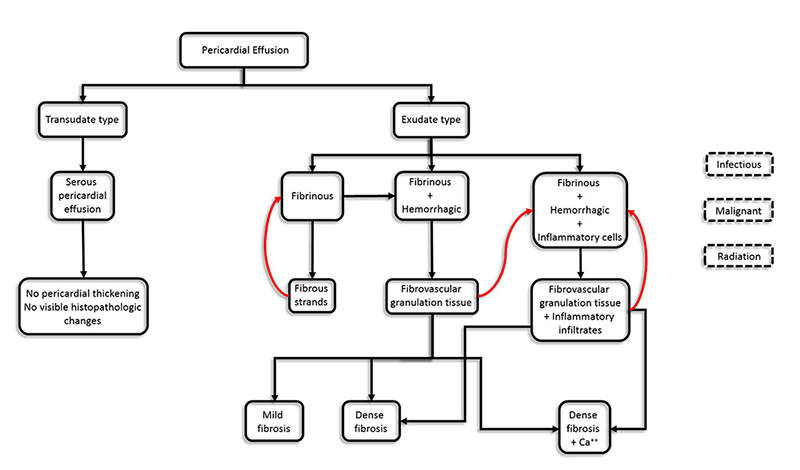Pericarditis - Histologic Stages of Organization
 This diagram show common responses of the pericardium to noxious stimuli result in diverse non-exclusive types of effusions.
This diagram show common responses of the pericardium to noxious stimuli result in diverse non-exclusive types of effusions.
A serous effusion may occur and be reabsorbed completely without leaving any histologic alteration. On the other hand, exudative effusions always leave a trace of the pericardial response to the injury.
The exudate of fibrin is the most common finding regardless of the source of injury: chemical (uremic, pharmaceuticals), physical (open heart surgery, therapeutic ablation, radiation) or infectious (viral, bacterial, fungal, parasitic).
Once the fibrinous or fibrino-hemorrhagic exudate occurs, there is usually an inflammatory response elicited that will “clean” the fibrinous debris. During this phase, the inflammatory cells promote the formation of neovascularization and early extracellular matrix deposition (granulation tissue). This process is referred to as "organization" and the histopathologic process is called organizing pericarditis. If the noxious stimulus ends, the result is usually mild fibrosis or organized pericarditis.
If the noxious stimulus persists, the response of the pericardium is prolonged in terms of the process of exudation, inflammation, and repair. The deposition of fibrosu tissue continues leading to fibrous pericarditis.
In recurrent pericarditis, the inflammatory response may wax and wane. The red arrows in the diagram illustrate points where a recurrent insult can occur again, thus modifying and lengthening the healing process. The repeated injury-repair cycles result in thickening of the parietal pericardium and adhesion to the visceral pericardium with obliteration of the pericardial cavity and constriction of the heart during diastole.
While commonly seen, calcification is not always a feature present during the healing of the pericardium.
Back to Pericardial disease
Back to Home Page

